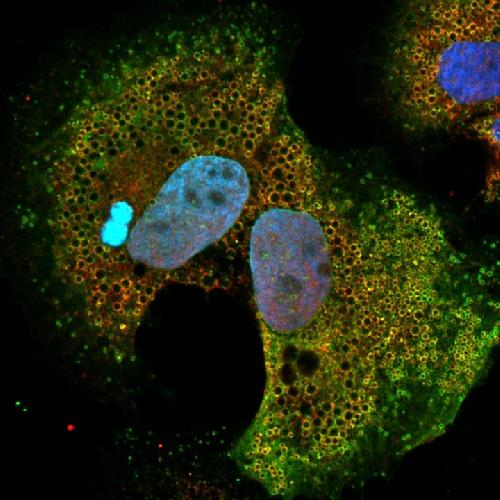Hepatitis C virus (HCV) hijacks the host's fat metabolism for its own survival, growth, and transport in the human body. A study published on April 28th in PLOS Pathogens identifies a host gene involved in the formation of HCV virus particles and helps explain why humans with a rare mutation in the gene have problems with their fat metabolism.
Lipid droplets are are involved in the regulation of fat storage and metabolism and found in the body´s fat cells and in liver cells (also called hepatocytes). Some pathogens, including HCV, which targets the liver, exploit the host's lipid droplets for their own propagation. In fact, HCV travels through in the blood as a lipo-viro particle, a lipid-rich blob that closely resembles human very low density lipoproteins (VLDL) such as cholesterol. And this camouflage makes it hard for the immune system to detect and fight the virus.
In a rational quest to find host factors involved in HCV infection, Gabrielle Vieyres and Thomas Pietschmann from Twincore in Hannover, Germany, with colleagues focused on a list of genes with proposed roles in the formation and maintenance of lipid droplets or VLDL. The researchers set up a system to systematically test whether any of these genes were essential for initial or chronic HCV infection, and found a number of candidates that appeared to affect different stages of the HCV life-cycle.
 ABHD5 (green) co-localizes with ADRP (red) to the lipid droplet surface ('donut' shape) in human liver-derived cells. Credit: Gabrielle Vieyres (Twincore, Hannover) (sample preparation & imaging).
ABHD5 (green) co-localizes with ADRP (red) to the lipid droplet surface ('donut' shape) in human liver-derived cells. Credit: Gabrielle Vieyres (Twincore, Hannover) (sample preparation & imaging).
They selected one of them, called ABHD5, for a more detailed analysis. ABHD5 stood out because mutations in the gene cause a rare human genetic disease called Chanarin-Dorfman syndrome (CDS) that causes defects in lipid storage, and also because the earlier tests suggested that the gene had an interesting role in lipid droplet metabolism.
More detailed experiments showed that ABHD5 had no effects on the entry of HCV into human cells or on the multiplication of the viral genome, but that ABHD5 expression levels specifically regulated the efficiency of virus assembly and release from the human host cells. Having identified ABHD5 as novel HCV assembly co-factor, the researchers tested two variants of the protein involved in CDS and found that both of the mutations abolished the protein's role in HCV assembly.
When the researchers examined the localization of ABDH5 in the cells, they found it preferentially at the surface of lipid droplets and the cellular secretion machinery, which are also the sites of HCV assembly. In HCV-infected cells, normal ABDH5 protein (but not the CDS mutants) consistently co-localized with virus components as well as other known host assembly factors.
Examining the functional consequences of the observed associations, the researchers saw fewer lipid droplets in cells expressing higher-than-normal levels of ABDH5. However, high levels of CDS mutant did not affect the cell lipid droplets. Moreover, cells with lower-than-normal ABDH5 levels showed accumulation of large numbers of lipid droplets.
By systematically mutating different parts of the ABHD5 protein, the researchers were able to identify a part of the protein that they called the 'tribasic lipid droplet consumption motif'. Mutations in this motif retained the protein's co-localization with lipid droplets but no longer promoted "consumption" of the droplet. The researchers speculate that mutation of the motif specifically abrogates ABHD5's interaction with its partner lipase (a lipid-degrading enzyme) and hope that "therefore this mutant will be a precious tool for the identification of ABHD5 effector lipase(s) in hepatocytes".
"Our findings", the researchers summarize, "indicate that ABHD5 supports HCV assembly and release by triggering the mobilisation of the lipid droplet stores for the assembly and release of infectious lipo-viro-particles. They shed light on host determinants of HCV and VLDL morphogenesis, on the role of ABHD5 in hepatocytes and the etiology [the biological origin] of the liver dysfunctions observed in the Chanarin-Dorfman patients".
source: PLOS